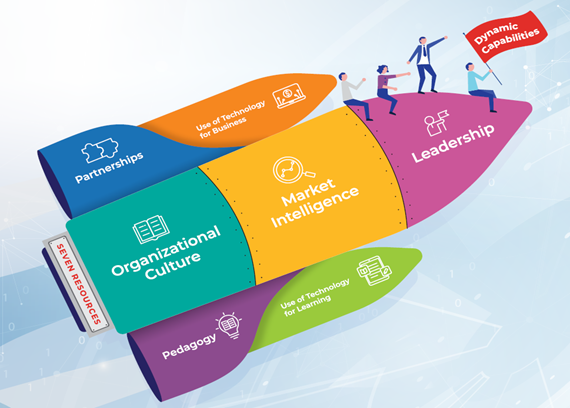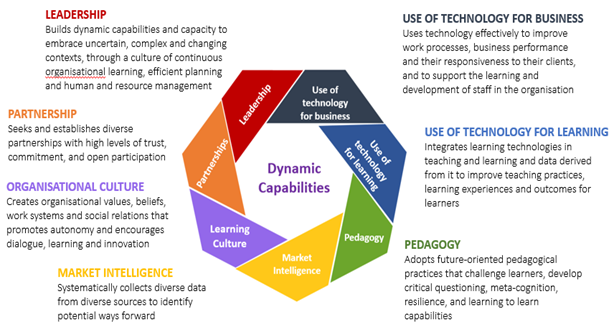By Chen Zan
By Chen Zan, Ilona Murphy
DYNAMIC CAPABILITIES TO HARNESS CHANGE AND GROW
What are dynamic capabilities?
Dynamic capabilities refer to an organisation's integration and building of internal and external resources to seek new opportunities for business growth and development, as shown in Figure 1. For training and adult education (TAE) providers, this means recognising shifts in the TAE landscape and beyond, identifying the changes needed, and to implement such opportunities in order to thrive in changing circumstances.
Dynamic capabilities move beyond the foundational capabilities an organisation must have. They are ‘dynamic’ because an organisation’s resources are put to work in different ways, at different points in time, for different purposes.
Figure 1 Dynamic Capabilities and Seven Resources for Business Growth
This framework draws on insights from the second iteration of the Training and Adult Education Landscape Study 2. As part of this study, we conducted over 50 interviews with 18 training organisations during 2021-2022 to understand how they make the most of changing circumstances.
What dynamic capabilities are needed?
When we first embarked on this study in 2021, a key focus at that time was on how TAE providers were responding to the impact of Covid-19. Through our data collection, we heard compelling stories of how TAE providers were diversifying, restructuring, repurposing and diversify their offerings. We also observed exemplar ways in which TAE professionals integrated technologies into their curriculum design and teaching and learning practices. Since then, advances in generative AI, popularised by ChatGPT has pushed the adoption of technology to its boundaries. However, one key challenge remains: the effective integration of technology with future oriented pedagogical practices. On a broader scale, changes in TAE policy, funding and regulation alongside geo-political tensions, climate change and their impact on labour markets are only some examples of the challenges that require TAE providers to develop dynamic capabilities.
Given that dynamic capabilities are an organisation’s ability to integrate, build, and reconfigure internal and external resources, these capabilities must be developed within the organisation to adapt to change and to cope with uncertainties. The focus is on the organisation as a collective whole, rather than any single department or individual. This involves people working across team and organisational boundaries, creating opportunities for people to think differently and push boundaries. This is a rich learning process that opens avenues for collaboration, knowledge sharing and the introduction of new and improved practices. Understanding dynamic capabilities in this relational context allow for the identification of new opportunities and the implementation of change.
How TAE providers use their dynamic capabilities?
Among the 18 training providers studied, six excelled in building dynamic capabilities to make the most of changing circumstances. This is evident in the unique way these organisations build, manage, adapt their resources to seize emerging opportunities, create competitive advantage and improve business performance.
But what are these resources? Our research identified these as leadership, organisational culture, market intelligence, partnerships, pedagogy, technology for business and technology for learning. Figure 2 explains these seven resources core to dynamic capabilities.
Figure 2 Seven Resources for Dynamic Capabilities Defined

The seven resources are distinct and yet relate to one another symbiotically. The providers uniquely integrate and utilise these resources in different ways to mobilise and enhance dynamic capabilities to harness change and grow.
To further illustrate the practical applications of the seven resources, we present a video below:
More detailed accounts will be available in an upcoming book.
The views and analysis presented in this Research Note are those of the authors as researchers. The content of the Research Note is intended for discussions and generating ideas. They are not necessarily the views or policy prescriptions of the Institute for Adult Learning (IAL).
This publication should be attributed as Chen, Z. & Murphy, I. (2024). Dynamic capabilities to harness change and grow. Institute for Adult Learning, Singapore.
This publication remains the copyright of IAL, Singapore and may not be reproduced without the permission of the Director of Research and Innovation, IAL. For further information on this publication, please email to [email protected]
For more information, see http://www.ial.edu.sg/
RD-2024-24
Copyright © 2024 Institute for Adult Learning
